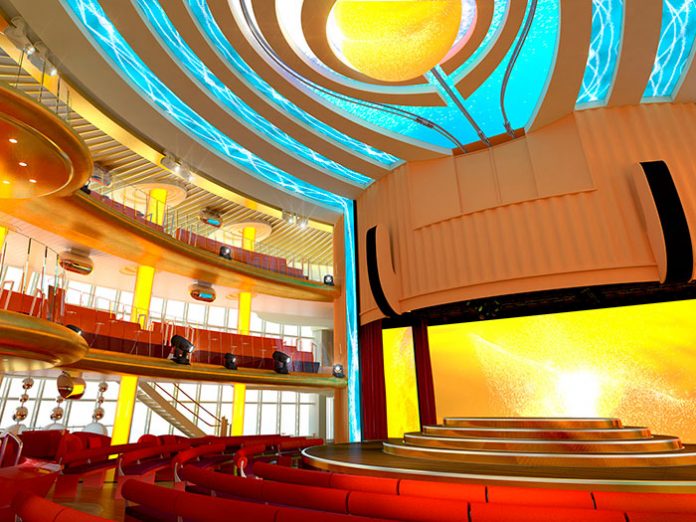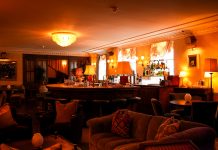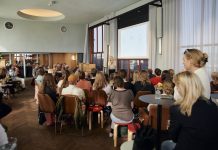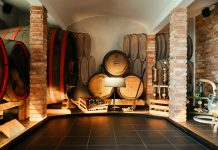The new AIDA cruises flagship was named AIDAprima by Emma Schweiger, young daughter of the German actor and film director Till Schweiger and herself an actress, as part of the annual festivities during the Hamburg port anniversary.
As a longtime trusted partner of the cruise company where the integration of media equipment into overall systems in the public entertainment areas is concerned, Amptown System Company (ASC) worked out the engineering concept for light, sound, entertainment IT network, communication and control with those responsible at AIDA Cruises, purchased and supplied the technical equipment, supervised the installation at the Japanese Mitsubishi shipyard in Nagasaki and undertook the final system commissioning.
300 metres long and 37.60 metres wide, the cruise liner accommodates 1,643 cabins of which 77 percent are fitted with a porch 6 square metres large. In 12 restaurants and 18 bars guests are invited to savour and enjoy whatever dishes and drinks they fancy.
The AIDAprima offers some very remarkable attractions, e.g. the Beach Club protected by a foil dome which can be visited in all weathers, the Four Elements deck with water slides, climbing facility and – this is a first – the AIDA Mini Club where toddlers of 6 months and upwards are looked after. Spacious cabins with porches, the Lanai deck with infinity pools, an exclusive patio deck with panorama cabins, numerous new restaurants, the Organic Body and Soul Spa wellness facilities with a surface area of 3,100 sqm, glazed elevators, a skywalk – to name but a few of the innovations which make the ship all the more attractive for cruises year-round.
Additionally equipped with an entirely new circular stage, state-of-the-art LED components, airframes for extraordinary artists’ shows, and a huge interactive floating LED ball, the Theatrium is the centrepiece of varied entertainment activities. Taking the huge size of the AIDAprima cruise liner into appropriate account, ASC developed an infrastructure which distributes audio signals across the entire ship via a fibre-based Optocore network. The various venues as e.g. the Theatrium, the Beach Club and the TV / broadcast area are interconnected via Optocore in a closed ring structure. Optocore components from the analog V3R and X6R series were installed throughout the ship.
For the first time ASC used a high-performance RTS ADAM-M intercom matrix as the central control unit in order to handle the very exacting communication requirements of this cruise ship’s various event areas. In addition to the conventional partyline communication this system enables a targeted point-to-point communication among the individual network nodes. The connection of the audio and intercom signals is ensured in both the analog and the digital mode. Digital communication is realised via the fully integrated RTS OMNEO media network architecture. OMNEO uses standard TCP-IP networks for multi-channel transmission of audio and data signals suitable for broadcasting virtually without delay. The IP network not only serves the numerous permanently installed RTS intercom stations but also allows for connecting more mobile communication stations to the intercom system anytime and anywhere on the ship wherever these may be required.
Wired communication for stage applications is ensured by a conventional RTS TW partyline system involving 15 BP-325 belt-packs and 12 WMS-300 wall mount substations which is connected to the central intercom system. A dual-channel RTS Radiocom UHF full-duplex wireless intercom system which is connected to the central matrix unit as well ensures mobile wireless communication. This intercom system consists of 3 BTR-800 base stations permanently installed in the central technical control facility below the Theatrium plus 2 TR-825 and 9 TR-800 wireless belt-packs to be used as mobile stations by the engineering staff on board.
The customer’s request for unlimited use of the wireless belt-packs everywhere on the ship represented a major challenge. Given the enormous size of the ship the distribution of antennas based on analog control was out of the question. That is why ASC decided on using the WIBER HF fibre-based distribution system produced by TheWirelessWorks. Throughout the ship, a total of 18 antennas located in the various entertainment areas is connected to the control centre bidirectionally via fiber-optic cables and thus enabled to send and receive signals in the UHF range.
The same infrastructure is used to connect 2 InEar Monitoring body-packs with the corresponding transmitters in the central technical control facility. In this way a moderator with his mobile camera team is supplied with intercom signals or program audio signals wherever he is on the ship.
The Theatrium is the central show venue of the AIDAprima extending over three decks. The mobile revolving stage projects far into the auditorium and is surrounded by audience rows in a 200 degree radius. Airframes with rails add substantially to the aerialists’ options with regard to artistic performance.
ASC laid out the main sound reinforcement system in the AIDAprima Theatrium using 20 Meyer Sound MINA Compact Curvilinear Array speakers and 2 self-powered Meyer Sound 1100-LFC (low-frequency control) Elements in all. Great importance was attached to installing active systems throughout the ship.
The factor ‘dynamics of the ship’ played a crucial role when ASC engineers laid out the sound equipment so as to account for the specific conditions encountered on cruise liner. Accordingly the line arrays are not simply suspended freely in space but are provided with attachment points in the bottom area. This arrangement confers more stability to the clusters as a whole securing them against the motion of the cruise ship at sea.
Like all subwoofers on the ship, the Meyer Sound 1100-LFC elements are placed on a foundation specifically designed by ASC which is separated from the hull by means of special foam blocks so as to minimise solid-borne sound transmission to the steel body of the ship. The main sound reinforcement system further includes 9 Meyer Sound UP4-XP active speakers integrated by ASC into the front edge of the stage as front fills.
Fifty-eight ultra-compact Meyer Sound UPM-1XP wide-coverage speakers in all and 18 self-powered Meyer Sound MM-4XP miniature speakers ensure clear and balanced sound in the back rows. Many of these speakers were supplied with a golden housing in harmonious correspondence with the interior design of the Theatrium. As far as this delay system goes ASC opted for XP types because the remote 19″ power supply unit considerably reduces the installation effort. Invisible to the guests 15 more Meyer Sound M1D subs are installed in benches and other pieces of furniture and ensure that low frequencies are evenly distributed in space.
All of the 113 loudspeakers are processed by 3 Meyer Sound Galileo 616 speaker management systems. Meyer Sound RMS (Remote Management System) remotely monitors the sound system.
A DiGiCo SD7 digital audio mixing console connected to the Optocore network is provided in the Theatrium. Sennheiser made all of the wireless microphone equipment.






